As Eid ul Azha comes to an end, there begins a flurry of activity in different government departments to prepare for the month of Muharram. It is a grand old process that has been meticulously planned over the years, with details from where the processions will begin, where they will pause, where food will be distributed all set out beforehand.
The process of Muharram every year follows a pattern. Religiously, it is a time of mourning, a moment to reflect on both Muslim and human history and to find lessons of sacrafice for the sake of principles. Practically, it is an annual moment of Bakhtinian carnival, where the everyday is subverted to allow the masses to mourn and practice their religious rites.
Ashura is an event, and a big one with a build-up and a climax, which means that it needs organisation. The government has to make special police deployments, set-up special control rooms, conduct checks on the venues of majalis and processions routes, and this year, the added job of ensuring coronavirus SOPs are followed. Other than the government, volunteers, organisations and private individuals also have to arrange for food, water, and religious memorabilia.
When there is a large event, there will be money involved, and Muharram involves everyone from television studios in Karachi planning special transmissions to metal workers in Lahore’s walled city. But what exactly does ensuring smooth operations for Muharram every year involve? Profit, takes a look.
Ensuring security
Unlike Eid, Muharram is a unique religious occasion, both because it takes place over a longer time period and because it involves mass public gatherings and processions. This year alone, there will be 36,464 Majalis and 9,127 processions during Muharram in Punjab alone according to the Province’s Central Police Office.
And these are only the processions that have been recorded, because the number of majalis and procession being held across the province is far greater than those on police record. There are no clear numbers on what the Shia population is in the country, since sect is not a question on the national census, the number is estimated to be anywhere from 10 to 25 percent.
With possibly a quarter of the country in mourning, the 9th and 10th of Muharram are public holidays, with public transport closing down, roads being blocked and only essential businesses remaining open. For these two days, and for the week leading up to them, a lot of the economic activity in the country also has to do with the observation of Muharram.
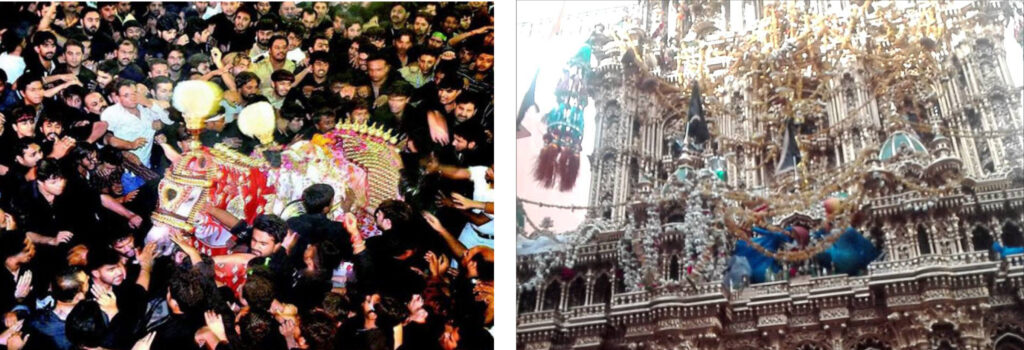 A 2011 report by Geo News estimated that Muharram related activities could be calculated up to Rs125 billion. Now, in 2020, this number will have increased manifold.
A 2011 report by Geo News estimated that Muharram related activities could be calculated up to Rs125 billion. Now, in 2020, this number will have increased manifold.
Profit conducted a case study of three union councils in Muzaffargarh – Union Council Budh, Union Council Gul Wala and Union Council Mehmood Kot – to gauge the effects of Muharram events and their expenses.
Preparation for Muharram
On the eve of Eidul Azha, the notables of Basti Nawan in Muzaffargarh’s union council Budh gathered to meet and make arrangements. The get-together was not an Eid Millan, but rather an informal meeting of the Anjuman Hussainia convened to decide on the preparations for Muharram.
The agenda for that night’s meeting was settling on clerics and zakirs that would come and tell the religious stories that year. One of the participants, Professor Mumtaz Hussain, put up a couple of names of zakireen, who should be booked for the Muharram majalis with the gathering in agreement with him. A call was put through.
“Hello, Rabbani sahib, Malik Tassaduq speaking from Imambargah Budh.” After exchanging pleasantries, Malik Tassaduq asked whether the zakir would be available for Ashura.
“Malik Sahib, I will be glad to be at your venue. But I can only present my services from 5pm to 6pm, as my other slots have already been taken. I am charging other places Rs 600,000 for Ashura; the same fee is for you people too.”
After a little bickering and arguments, both sides agreed to Rs500,000 where the zakir would recite majlis every day from 5pm to 6pm. In a second phone call, the proposed maulvi was also arranged at Rs300,000 for 10 days of Muharram.
Getting a good zakir is the lifeblood of any Imam Bargah during the Muharram season. It is, after all, the zakir that retells the tales of Ashura and revives the emotions of mourning that come with Ashura. In addition to this, the more prominent the zakir, the more devotees they will pull in and the more donations that will walk through the door as well. For private individuals that host Muharram gathering at their homes, getting a famous Zakir is a point of pride as well.
Other expenses for these Muharram gatherings include lighting, amplifiers, security, a little repair of the imambargah, preparation of ziarat and a daily langar. The total money required for the event was Rs 1.2 million. Of the present people, six people agreed to pay Rs 100,000 each, while the remaining promised an amount ranging from Rs 10,000 to Rs 50,000. All those contributing handsome amounts are mentioned in the majlis pamphlet which is printed and pasted at all major places of the locality. Its electronic version is also circulated through social media.
“Even if someone backs out the promised amount, the anjuman does not panic as it collects a handsome money running in lakhs from ziarat where mourners present the money every night and that money is also included in the budget,” says Malik Tahseen, a major contributor to the anjuman.
The anjuman holds its meeting only before Muharram, while during the Muharram, several volunteers join the ranks to perform different duties, such as security, looking after the zakir and the maulvi, langar distribution, etc.
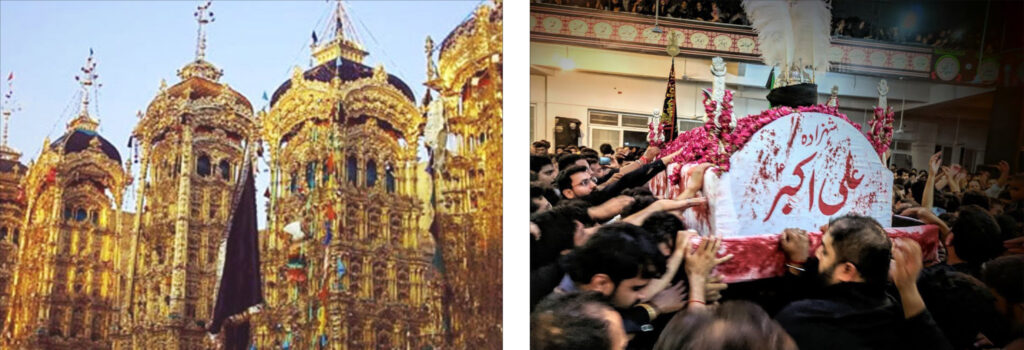
This year, of course, things are a little different because of the coronavirus pandemic. While the pandemic has slowed in Pakistan, it is still very much a major threat, and as such, Eid and Muharram were the two events where extra caution was urged by the government. The sentiment was reflected in a few participants of the meeting, who suggested that the majalis should be put on hold because of the threat of coronavirus. However, this was not a popular opinion, with most unimpressed by the argument.
This particular Imam Bargah, where the cost of operations is Rs 1.2 million, is not even one of the traditional license holders or on the traditional route for the Muharram processions. There are only 10 ‘official’ venues in the Union Council, which come to life during this month. In these places where there is more footfall, the costs go up to more than Rs 10 million. One place, called Basti Buk wali, located in the heart of deserts on the western side of Muzaffargarh city, arranges four to six zakirs and their budget exceeds Rs 20 million.
By all safe estimates, it can be said that Rs 10 million is spent on azadari in these three union councils of Muzaffargarh. The total number of union councils of Muzaffargarh district is 93, and if a union council spends Rs 3 million on average on Muharram azadari, that means Rs 930 million are spent, and this is a conservative estimate. This does not yet include the whole economic spectrum as several dozen majalis are conducted at individuals’ houses and food is prepared and dished out among mourners every single day by private individuals.
According to the released figures by Chaudhry Sajid Rasul, director general of the Bureau of Statistics, Punjab Planning & Development Board, there are total 4,015 union councils in Punjab and of them 734 are urban and 3,281 rural whereas 35 are in cantonment boards. Urban union councils spend more money on majalis and processions. When counted union councils wise, the expenses being incurred by the venue caretakers run in billions.
Major expenses
While orators are a major expense, every year when Muharram arrives, the venues where these zakirs deliver their sermons and tell the stories of Karbala have to be repaired, renovated, and prepared for an influx of visitors.
The historic Imambargah Nisar Haveli in Lahore is located 300 metres from the main Mochi Gate on Circular Road in a narrow and dingy lane. During Muharram, it becomes the centre of attraction for from here the main zuljinah procession is taken out. During Ashura, the haveli gets crowded every day in the evening as mourners in the hundreds turn to the haveli to attend majalis and mourning gatherings.
Syed Agha Hassan Abbas Kazmi is one of the organisers of the Imambargah. He said that this year this year, the event cost them Rs 500,000 in terms of lights, repair, amplifier, banners, and stage from where the orator addresses the majlis. He said they would spend an extra amount on the daily disinfection of the venue because of the coronavirus. They bought 10 thermometers for temperature checking of the participants and spent Rs 100,000 on the test of 20 volunteers’ coronavirus tests.
In Karachi, the Ancholi Imambargah is one of the centres of azadari. Though no structured data is available, according to informal estimates by the police department, there are 3,000 imambargahs in Karachi alone. The number of majalis being conducted in homes also runs in several thousands. And every majlis needs certain arrangements. The preparation of a majlis needs a public address system, tents, sheets, banners, and stage. According to conservative estimates, at least half a million is spent just to prepare these venues to be ready for Muharram.
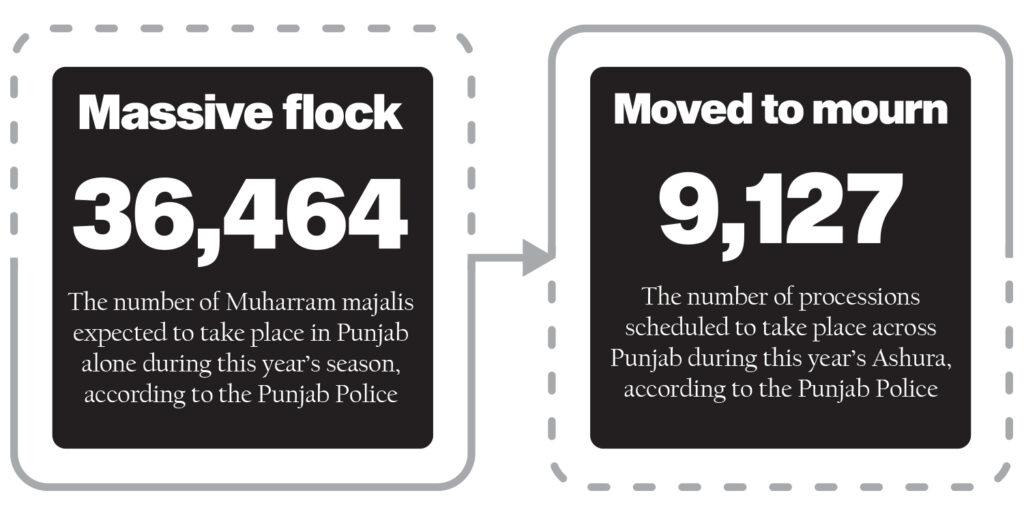
It is on top of this that the fees of the Zakirs have to be counted. Zakir Waseem Abbas Baloch, of Laalian, is in high demand in Punjab for example. According to those having interest in the affairs of majalis, Zakir Waseem Baloch charged Rs 3 million per imambargah for Ashura in 2109. He served at five places and thus earned Rs 15 million in the Muharram days alone. On other days, he charged Rs70,000 to 100,000 per majlis.
“This year, it is heard, Waseem has been booked for Rs 4 million per place,” said Mubasher Bukhari, who is the caretaker of Imambargah Mozang in Lahore. Zakir Waseem Baloch is not an usual case who charges millions. “There are hundreds of zakirs and maulvis who charge more than a million for the Muharram days,” says Mubasher Bukhari.
Allama Hafiz Tassaduq Hussain charged Rs 2.5 million from the organizers of a Muharram Ashra in Rawalpindi imambargah in 2019. Zakireen’s fees are high because of their more demand and less supplies. A zakir’s fee is the major chunk of an imambargah’s Muharram activity.
However, there are also other more humanitarian expenditures such as the distribution of langar among people. Tandoors and other places that prepare food in large quantities have to be on their toes during Muharram. One of them is Sadiq Pakwan Centre in Gulberg II Lahore, which has hired special staff for Muharram.
“We get more orders of degs during Muharram than we do during peak wedding season,” Muhammad Sadiq, the proprietor of the catering services, told Profit. He said that for the 1st of Muharram, he got orders of 25 degs of Haleem and as many of Biryani. He supplied these meals to the majalis of women being conducted in different houses in Jinnah Park, and Gulberg II areas of Lahore. He is going to charge Rs 7,500 for a Haleem Deg and Rs6,500 for a biryani deg. Once again, these are completely private gatherings that often go unrecorded in the economic impact that Muharram has.
In addition to langar, there is also the expense that comes with ziarat, which are symbolic representations of the events of Ashura. Most important among these are the Zuljinah horses, carefully reared and venerated to be brought out on Ashura.
In Nisar Haveli, a sea of mourners start their 20-hour procession from the imambargah on the eve of Ashur which concludes in the evening the next day at Karbala Gamay Shah on Lower Mall. The Zuljinnah which leads the procession has to be taken care of because it is the centre of activity and is greeted with respect and tears by mourners.
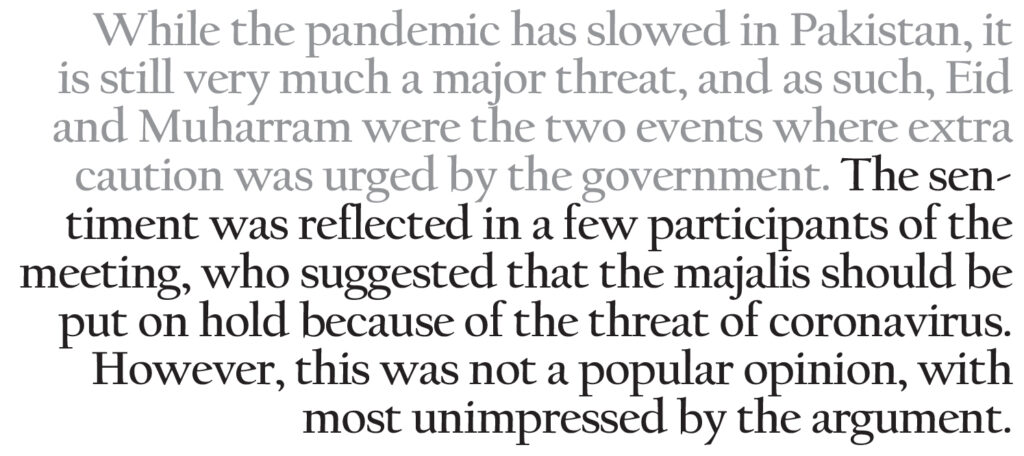
During the procession’s march, the harness of the Zuljinnah is held by Agha Ali Jan Qazalbash, the grandson of Nawab Muzaffar Ali Qazalbash, the former Chief Minister of West Pakistan. This is also a power show of the Nawab family, which holds the licence of the 150-year-old traditional route. The Zuljinnah’s traditional attires and armors cost handsome money. The Nawab family rears a team of six studs at their Empress Road Nawab Palace.
The upkeep of Zuljinnah is a constant and expensive affair. Zuljinnah depicts the ride of Hazrat Imam Hussain in his final hour at the battle of Karbala. It wears a saddle, an embodied sheet, traditional shields, a wreath of flowers, a sword, a crown and a rein. A Ta’azia is prepared from Rs100,000 to Rs 1 million, mostly in Chiniot. Syed Khizer Gillani of Mehmood Kot said they prepared a Taazia from a Chiniot artisan against Rs300,000 this year.




















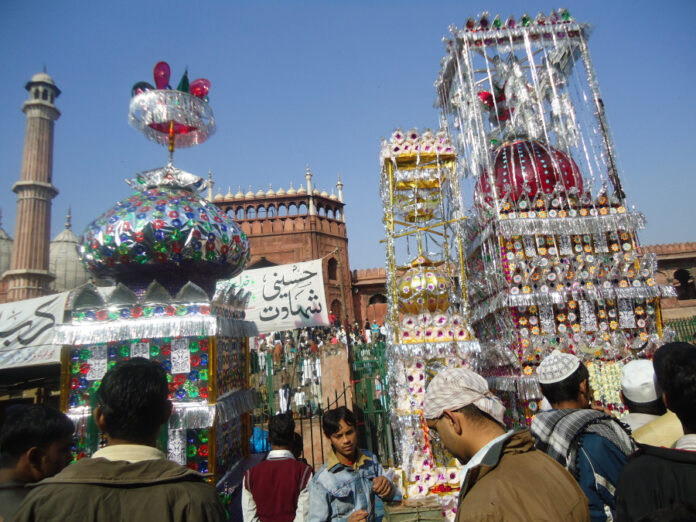





The possessions taken out in different cities of the country needs to stop, not just for Muharram but also for 12 rabi ul Awal or for any other religious reasons. These are not required under any sect of Islam!. If someone has to do a religious activity the govt should designate a large open ground where all these activities can be performed in each city, instead of closing half the city and cell phone services across Pakistan. What a waste of time and resources to the already resource starved country!!!
I am also concerned about the language being used by the two main stream sects during these activities as we are heading towards a serious sectarian violence until it is controlled now.